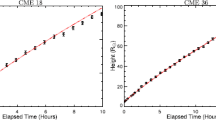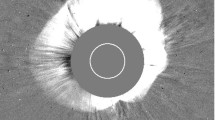Abstract
We study the relationship between the speeds of coronal mass ejections (CMEs) obtained close to the Sun and in the interplanetary medium during the low solar-activity period from 2008 to 2010. We use a multi-spacecraft forward-modeling technique to fit a flux-rope-like model to white-light coronagraph images from the STEREO and SOHO spacecraft to estimate the geometrical configuration, propagation in three-dimensions (3D), and the radial speeds of the observed CMEs. The 3D speeds obtained in this way are used in existing CME travel-time prediction models. The results are compared to the actual CME transit times from the Sun to STEREO, ACE, and Wind spacecraft as well as to the transit times calculated using projected CME speeds. CME 3D speeds give slightly better predictions than projected CME speeds, but a large scatter is observed between the predicted and observed travel times, even when 3D speeds are used. We estimate the possible sources of errors and find a weak tendency for large interplanetary CMEs (ICMEs) with high magnetic fields to arrive faster than predicted and small, low-magnetic-field ICMEs to arrive later than predicted. The observed CME transit times from the Sun to 1 AU show a particularly good correlation with the upstream solar-wind speed. Similar trends have not been observed in previous studies using data sets near solar maximum. We suggest that near solar minimum a relatively narrow range of CME initial speeds, sizes, and magnetic-field magnitudes led to a situation where aerodynamic drag between CMEs and ambient solar wind was the primary cause of variations in CME arrival times from the Sun to 1 AU.






Similar content being viewed by others
References
Brueckner, G.E., Howard, R.A., Koomen, M.J., Korendyke, C.M., Michels, D.J., Moses, J.D., Socker, D.G., Dere, K.P., Lamy, P.L., Llebaria, A., Bout, M.V., Schwenn, R., Simnett, G.M., Bedford, D.K., Eyles, C.J.: 1995, The large angle spectroscopic coronagraph. Solar Phys. 162, 357. ADS: 1995SoPh..162..357B . doi: 10.1007/BF00733434 .
Cargill, P.J.: 2004, On the aerodynamic drag force acting on interplanetary coronal mass ejection. Solar Phys. 221, 135 – 149.
Chen, J., Howard, R.A., Brueckner, G.E., Santoro, R., Krall, J., Paswaters, S.E., St. Cyr, O.C., Schwenn, R., Lamy, P., Simnett, G.M.: 1997, Evidence of an erupting magnetic flux-rope: LASCO coronal mass ejection of 1997 April 13. Astrophys. J. Lett. 490, L191. doi: 10.1086/311029 .
Corona-Romero, P., Gonzalez-Esparza, J.A.: 2011, Numerical and analytic study of interplanetary coronal mass ejection and shock evolution: Driving, decoupling, and decaying. J. Geophys. Res. 116, A05104. doi: 10.1029/2010JA016008 .
Gonzalez, W.D., Chía de Gonzalez, A.L., Dal Lago, A., Tsurutani, B.T., Arballo, J.K., Lakhina, G.K., Buti, B., Ho, C.M., Wu, S.-T.: 1998, Magnetic cloud field intensities and solar wind velocities. Solar Phys. 25, 963 – 966.
Gopalswamy, N., Lara, A., Lepping, R.P., Kaiser, M.L., Berdichevsky, D., St. Cyr, O.C.: 2000, Interplanetary acceleration of coronal mass ejections. Geophys. Res. Lett. 27, 145 – 148. doi: 10.1029/1999GL003639 (G2000).
Gopalswamy, N., Lara, A., Yashiro, S., Kaiser, M.L., Howard, R.A.: 2001, Predicting the 1-AU arrival times of coronal mass ejections. J. Geophys. Res. 106, 29 207 – 29 217. doi: 10.1029/2001JA000177 (G2001).
Howard, R.A., Nandy, D., Koepke, A.C.: 2008, Kinematic properties of solar coronal mass ejections: Correction for projection effects in spacecraft coronagraph measurements. J. Geophys. Res. 113, A01104. doi: 10.1029/2007JA012500 .
Howard, R.A., Michels, D.J., Sheeley, N.R., Koomen, M.J. Jr.: 1982, The observation of a coronal transient directed at Earth. Astrophys. J. Lett. 263, L101 – L104. doi: 10.1086/183932 .
Howard, R.A., Moses, J.D., Vourlidas, A., Newmark, J.S., Socker, D.G., Plunkett, S.P., et al.: 2008, Sun Earth connection coronal and heliospheric investigation (SECCHI). Space Sci. Rev. 36, 67.
Hundhausen, A.J.: 1993, Sizes and locations of coronal mass ejections – SMM observations from 1980 and 1984 – 1989. J. Geophys. Res. 98, 13 177 – 13 200. doi: 10.1029/93JA00157 .
Huttunen, K.E.J., Koskinen, H.E.J., Schwenn, R.: 2002, Variability of magnetospheric storms driven by different solar wind perturbations. J. Geophys. Res. 107, SPM 20-1-2002.
Jian, L., Russell, C.T., Luhmann, J.G.: 2011, Comparing solar minimum 23/24 with historical solar wind records at 1 AU. Solar Phys. 274, 321–344. ADS: 2011SoPh..274..321J . doi: 10.1007/s11207-011-9737-2 .
Jian, L., Russell, C.T., Luhmann, J.G., Skoug, R.M.: 2006, Properties of interplanetary coronal mass ejections at one AU during 1995 – 2004. Solar Phys. 239, 393 – 436. ADS: 2006SoPh..239..393J . doi: 10.1007/s11207-006-0133-2 .
Kaiser, M., Kucera, T.A., Davila, J.M., St. Cyr, O.C., Guhathakurta, M., Christian, E.: 2007, The STEREO mission: An introduction. Space Sci. Rev. doi: 10.1007/s11214-007-9277-0 .
Kilpua, E.K.J., Pomoell, J., Vourlidas, A., Vainio, R., Luhmann, J., Li, Y., Schroeder, P., Galvin, A.B., Simunac, K.: 2009, STEREO observations of interplanetary coronal mass ejections and prominence deflection during solar minimum period. Ann. Geophys. 27, 4491 – 4503. doi: 10.5194/angeo-27-4491-2009 .
Kilpua, E.K.J., Lee, C.O., Luhmann, J.G., Li, Y.: 2011, Interplanetary coronal mass ejections in the near-Earth solar wind during the minimum periods following solar cycles 22 and 23. Ann. Geophys. 29. doi: 10.5194/angeo-29-1455-2011 .
Linday, G.M., Luhmann, J.G., Russell, C.T., Gosling, J.T.: 1999, Relationships between coronal mass ejection speeds from coronagraph images and interplanetary characteristics of associated interplanetary coronal mass. J. Geophys. Res. 104, 12515 – 12523. doi: 10.1029/1999JA900051 .
Maris, G., Maris, O.: 2012, High speed streams in the solar wind during the 23rd solar cycle. In: Maris, G., Demetrescu, C. (eds.) Advances in Solar-Terrestrial Physics, Research Signpost, Trivandrum, 97 – 134.
Odstrcil, D., Pizzo, V.J., Arge, C.N.: 2005, Propagation of the 12 May 1997 interplanetary coronal mass ejection in evolving solar wind structure. J. Geophys. Res. 110. doi: 10.1029/2004JA010745 .
Owens, M., Cargill, P.: 2004, Predictions of the arrival of coronal mass ejections at 1 AU, an analysis of causes of error. Ann. Geophys. 22, 661 – 671 (O2004).
Pizzo, V.J., Millward, G., Parsons, A., Biesecker, D., Hill, S., Odstrcil, D.: 2011, Wang–Sheeley–Arge–Enlil cone model transitions to operations. Space Weather 9. doi: 10.1029/2011SW000663 .
Richardson, I.G., Cane, H.V.: 2010, Near-Earth interplanetary coronal mass ejections during solar cycle 23 (1996 – 2009): Catalog and summary of properties. Solar Phys. 264, 189 – 237. ADS: 2010SoPh..264..189R . doi: 10.1007/s11207-010-9568-6 .
Rodriguez, L., Mierla, M., Zhukov, A.N., West, M., Kilpua, K.E.J.: 2011, Linking remote-sensing and in situ observations of coronal mass ejections using STEREO. Solar Phys. 70, 561 – 573. ADS: 2011SoPh..270..561R . doi: 10.1007/s11207-011-9784-8 .
Russell, C.T., Mulligan, T.: 2002, On the magnetosheath thicknesses of interplanetary coronal mass ejections. Planet. Space Sci. 50, 527.
Russell, C.T., Shinde, A.A., Jian, L.: 2005, A new parameter to define interplanetary coronal mass ejections. Adv. Space Res. 12, 2178 – 2184.
Schwenn, R., Dal Lago, A., Huttunen, K.E.J., Gonzalez, W.D.: 2005, The association of coronal mass ejections with the effects of their counterparts near the Earth. Ann. Geophys. 23, 1033 – 1059.
St. Cyr, O.C., Howard, R.A., Sheeley, N.R., Plunkett, S.P., Michels, D.J., Paswaters, S.E., Koomen, M.J., Simnett, G.M., Thomson, B.J., Gurman, J.B., Schwenn, R., Webb, D.F., Hildner, E., Lamy, P.L.: 2000, Properties of coronal mass ejections: SOHO LASCO observations from January 1996 to June 1998. J. Geophys. Res. 105. doi: 10.1029/1999JA000381 .
Thernisien, A.F.R., Howard, R.A., Vourlidas, A.: 2006, Modeling of flux-rope coronal mass ejections. Astrophys. J. 652, 763 – 773.
Thernisien, A.F.R., Vourlidas, A., Howard, R.A.: 2009, Forward modeling of coronal mass ejections using STEREO/SECCHI data. Solar Phys. 256, 111 – 130. ADS: 2009SoPh..256..111T . doi: 10.1007/s11207-009-9346-5 .
Tsurutani, B.T., Smith, E.J., Gonzalez, W.D., Tang, F., Akasofu, S.I.: 1988, Origin of interplanetary southward magnetic fields responsible for major magnetic storms near solar maximum (1978 – 1979). J. Geophys. Res. 93, 8519.
Vourlidas, A., Howard, R.A., Esfandiari, E., Patsourakos, S., Yashiro, S., Michalek, G.: 2011, Erratum: “Comprehensive analysis of coronal mass ejection mass and energy properties over a full solar cycle”. Astrophys. J. 730, 1.
Vršnak, B., Gopalswamy, N.: 2001, Influence of aerodynamic drag on the motion of interplanetary ejecta. J. Geophys. Res. 107. doi: 10.1029/2001/JA000120 .
Vršnak, B., Žic, T., Falkenberg, T.V., Möstl, C., Vennerstrom, S., Vrbanec, D.: 2011, The role of aerodynamic drag in propagation of interplanetary coronal mass ejections. Astron. Astrophys. 512. doi: 10.1051/0004-6361/200913482 .
Wang, Y.-M., Robbrecht, E., Sheeley, N.R. Jr.: 2009, On the weakening of the polar magnetic fields during solar cycle 23. Astrophys. J. 707, 1372.
Yashiro, S., Gopalswamy, N., Michalek, G., St. Cyr, O.C., Plunkett, S.P., Rich, N.B., Howard, R.A.: 2004, A catalog of white light coronal mass ejections observed by the SOHO spacecraft. Solar Phys. 109. doi: 10.1029/2003JA010282 .
Zhang, J., Richardson, I.G., Webb, D.F., Gopalswamy, N., Huttunen, K.E.J., Kasper, J., Nitta, N.W., Poomvises, W., Thompson, B.J., Wu, C.-C., Yashiro, S., Zhukov, A.N.: 2007, Solar and interplanetary sources of major geomagnetic storms (Dst<−100 nT) during 1996 – 2005. J. Geophys. Res. 112, A10102. doi: 10.1029/2007JA012321 .
Zurbuchen, T.H., Richardson, I.G.: 2006, In-situ solar wind and magnetic field signatures of interplanetary coronal mass ejections. Space Sci. Rev. 123, 1572.
Acknowledgements
STEREO suprathermal electron pitch-angle distributions were achieved through the CESR SWEA server. We thank Andrea Opitz for validating the STEREO pitch-angle distributions. The LASCO CME catalog is generated and maintained at the CDAW Data Center by NASA and The Catholic University of America in cooperation with the Naval Research Laboratory. SOHO is a project of international cooperation between ESA and NASA. STEREO magnetic-field and plasma data were accessed through the UCLA Space Physics Center. Academy of Finland projects 130298 and 1218152 are thanked for their financial support. Marilena Mierla acknowledges the financial support from the project TE 73/11.08.2010 and from ROB. The authors thank the STEREO/SECCHI consortium for providing the data. The SECCHI data used here were produced by an international consortium of the Naval Research Laboratory (USA), Lockheed Martin Solar and Astrophysics Lab (USA), NASA Goddard Space Flight Center (USA), Rutherford Appleton Laboratory (UK), University of Birmingham (UK), Max-Planck-Institut for Solar System Research (Germany), Centre Spatiale de Liège (Belgium), Institut d’Optique Theorique et Appliquée (France), and Institut d’Astrophysique Spatiale (France). The work by Nandita Srivastava and Luciano Rodriguez partially contributes to the research for the European Union Seventh Framework Programme (FP7/2007 – 2013) under grant agreement number 263252 [COMESEP]. Luciano Rodriguez and Matthew West acknowledge support from the Belgian Federal Science Policy Office through the ESA-PRODEX program.
Author information
Authors and Affiliations
Corresponding author
Rights and permissions
About this article
Cite this article
Kilpua, E.K.J., Mierla, M., Rodriguez, L. et al. Estimating Travel Times of Coronal Mass Ejections to 1 AU Using Multi-spacecraft Coronagraph Data. Sol Phys 279, 477–496 (2012). https://doi.org/10.1007/s11207-012-0005-x
Received:
Accepted:
Published:
Issue Date:
DOI: https://doi.org/10.1007/s11207-012-0005-x




